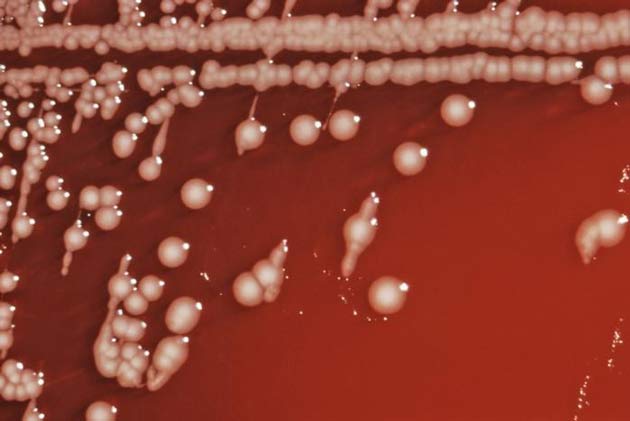Deadly Bacteria Sacrifice and Cooperate

Cooperation is so pervasively human that expressions of it can be seen in all groups of people, regardless of culture or age. From children to corporations to entire nations, some play nicer than others. But cooperative and non-cooperative behavior is not uniquely human. The survival of many other organisms, including bacteria, depends at times on individual members cooperating.
One extreme expression of cooperation is when some members of a population sacrifice themselves for the good of the many.
According to an article in the journal Nature last month, this sort of "self-destructive" cooperation is essential for the infection cycle of the pathogen Salmonella typhimurium, which causes salmonella, the most frequently reported food borne illness in the United States. One recent outbreak of salmonella occurred just this summer, when more than a 1,400 people all over the United States suffered diarrhea, fever, and abdominal cramps after eating jalapeño peppers from Mexico.
Salmonella often starts when someone eats a raw food contaminated with the bacteria – perhaps as few as a hundred individual cells. For the infection to "take," this small initial population must colonize the gut. Already filled with competing microbes, the human digestive tract is a very unfriendly place for invading bacteria. If they somehow manage to out-compete the existing microbes, they still have the destructive forces of the human immune system to contend with.
The new research suggests that Salmonella bacteria survive thanks to a genetically-encoded cooperative strategy. All the bacteria within the small initial population are genetically identical, but nevertheless two groups emerge. Establishing an infection requires the coordinated action between the two groups—one that goes kamikaze and one that waits in the wings to take advantage of the ensuing destruction.
Looking at Salmonella infections in mice, a team of scientists led by Martin Ackermann and Wolf-Dietrich Hardt of ETH Zurich in Switzerland Michael Doebeli of the University of British Columbia modeled the cooperative behavior of the two groups of bacteria using a variation of what is known as the public goods game. This is a classic problem in game theory that economists use to model the outcomes of a negotiation.
The public goods game is like a gambling exercise with no cards. Participants have a certain number of tokens that they can secretly contribute to a common pot. At the end of the game, all players get to keep whatever tokens they started with plus and an even split of the common pot. Game theory says that the best strategy for the entire group is for each player to throw all their chips in the pot, turning them into public goods and sharing them equally.
Sign up for the Live Science daily newsletter now
Get the world’s most fascinating discoveries delivered straight to your inbox.
Salmonella plays a dangerous variation of the public goods game in the human gut. Certain of the bacterial players contribute nothing at all. Others are self-destructive, throwing in all their chips and then taking themselves out of the game. In the end, the bacteria that contribute nothing are left to share these spoils left behind.
How this plays out biologically is that after the bacteria divide into two groups in the gut, one group essentially does nothing and stays inside the intestinal cavity while the other group invades the cells lining the intestines. The second group is doomed. Invading the intestinal cells touches off a massive immune response that these bacteria cannot survive. They ultimately add to the common goods, however, because their self-destruction also causes massive inflammation inside the gut that wipes out many of the existing microbes there.
With their competitors gone, the remaining bacteria can multiply into a widespread infection.
The curious part of all this is that both groups of the bacteria are genetically identical even though some of them are driven towards self destruction. The difference arises not because of genetic differences but because of what the scientists call "phenotypic noise"—random assortment of proteins and other molecular processes that occur during cell division. All the bacteria have the genes that drive the self-destructive behavior, but not all of them express these genes.
This is an elegant adaptation, says Ackermann, and it makes sense. If the two groups of bacteria were not genetically identical, the self-destructive form would be quickly wiped out. Instead, if some percentage of a population is programmed to randomly begin cooperating self-destructively, then the population as a whole will survive (and anyone eating the bad jalapeños will pay the price).
- Salmonella's Tricky Attack Plan Revealed
- Scientists Examine 100 Trillion Microbes in Human Feces
- Does Washing Fruits and Vegetables Make Them Safe?
Inside Science News Service is supported by the American Institute of Physics.









